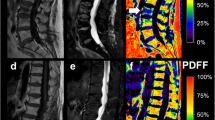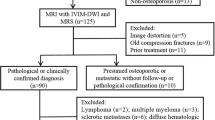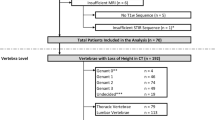Abstract
Objectives
To determine the residual lipid fraction in fractured vertebrae by 1H MR spectroscopy (MRS) and its confounding effect on differentiating benign from metastatic compression fractures of the spine using apparent diffusion coefficient (ADC) obtained by diffusion-weighted read-out-segmented echo-planar imaging.
Methods
Fifty-two patients presenting with back pain and/or vertebral compression fractures related to different degrees of acute trauma, osteoporosis or clinically known metastatic disease underwent imaging at 1.5 T using (a) single-voxel MRS for water and lipid compositions over the fractured vertebral marrow, and (b) DWI at b = 0 and 650 s/mm2 to compute the ADC values.
Results
In 46 fractured vertebrae, the amount of lipid displaced was variable. In low-impact trauma, lipid was either displaced partially (ADC of 1.60 ± 0.20 × 10−3 mm2/s) or almost totally with a higher ADC (2.20 ± 0.27 × 10−3 mm2/s). In acute high-impact trauma, the lipid fraction was negligible, yet an intermediate ADC was observed. In tumour infiltration, ADC was also intermediate (1.22 ± 0.14 × 10−3 mm2/s) despite a negligible lipid fraction. The ROC curve yielded a diagnostic accuracy of 0.944.
Conclusion
ADC-MRS analysis provides knowledge of the residual lipid fraction in fractured vertebrae that could aid in the differentiation between benign and metastatic vertebral fractures in low-impact trauma.
Key Points
• Trauma causes displacement of lipid in normal vertebral bone marrow.
• A high content of remaining lipids confounds and lowers the ADC.
• ADC alone is ambiguous in differentiating osteoporotic and neoplastic vertebral fractures.
• Differentiation is aided by using ADC in combination with MRS.
• Diffusion-weighted read-out-segmented echo-planar imaging improves spinal image quality.





Similar content being viewed by others
Abbreviations
- DW-rs-EPI:
-
diffusion-weighted read-out-segmented echo-planar imaging
- DW-ss-EPI:
-
diffusion-weighted single-shot echo-planar imaging
References
Vaccaro AR, Kim DH, Brodke DS et al (2003) Diagnosis and management of thoracolumbar spine fractures. J Bone Joint Surg Am 85:2456–2470
Falcone S (2002) Diffusion-weighted imaging in the distinction of benign from metastatic vertebral compression fractures: is this a numbers game? Am J Neuroradiol 23:5–6
Baur A, Stabler A, Bruning R et al (1998) Diffusion-weighted MR imaging of bone marrow: differentiation of benign versus pathologic compression fractures. Radiology 207:349–356
Balliu E, Vilanova JC, Peláez I et al (2009) Diagnostic value of apparent diffusion coefficients to differentiate benign from malignant vertebral bone marrow lesions. Eur J Radiol 69:560–566
Bammer R, Herneth AM, Maier SE et al (2003) Line scan diffusion imaging of the spine. Am J Neuroradiol 24:5–12
Baur A, Huber A, Ertl-Wagner B et al (2001) Diagnostic value of increased diffusion weighting of a steady-state free precession sequence for differentiating acute benign osteoporotic fractures from pathologic vertebral compression fractures. Am J Neuroradiol 22:366–372
Zhou XJ, Leeds NE, McKinnon GC, Kumar AJ (2002) Characterization of benign and metastatic vertebral compression fractures with quantitative diffusion MR imaging. Am J Neuroradiol 23:165–170
Rumpel H, Chan LL, Chan LP, Png MA, Tan RK, Lim WE (2006) Vertebrae adjacent to spinal bone lesion are inconsistent reference markers: a magnetic resonance spectroscopic viewpoint. J Magn Reson Imaging 23:574–577
Castillo M (2003) Diffusion-weighted imaging of the spine: is it reliable? Am J Neuroradiol 24:1251–1253
Shah LM, Hanrahan CJ (2011) MRI of spinal bone marrow: part 1, techniques and normal age-related appearances. Am J Roentgenol 197:1298–1308
Kugel H, Jung C, Schulte O, Heindel W (2001) Age- and sex-specific differences in the 1H-spectrum of vertebral bone marrow. J Magn Reson Imaging 13:263–268
Schellinger D, Lin CS, Lim J, Hatipoglu HG et al (2004) Bone marrow fat and bone mineral density on proton MR spectroscopy and dual-energy X-ray absorptiometry: their ratio as a new indicator of bone weakening. Am J Roentgenol 183:1761–1765
Ragab Y, Emad Y, Gheita T et al (2009) Differentiation of osteoporotic and neoplastic vertebral fractures by chemical shift in-phase and out-of phase MR imaging. Eur J Radiol 72:125–133
Swartz PG, Roberts CC (2009) Radiological reasoning: bone marrow changes on MRI. Am J Roentgenol 193:S1–S4
Porter DA, Heidemann RM (2009) High resolution diffusion-weighted imaging using readout-segmented echo-planar imaging, parallel imaging and a two-dimensional navigator-based reacquisition. Magn Reson Med 62:468–475
Lenchik L, Rogers LF, Delmas PD et al (2004) Diagnosis of osteoporotic vertebral fractures: importance of recognition and description by radiologists. Am J Roentgenol 183:949–958
Miller KL, Pauly JM (2003) Non-linear phase correction for navigated diffusion imaging. Magn Reson Med 50:343–353
Griswold MA, Jakob PM, Heidemann RM et al (2002) Generalized autocalibrating partially parallel acquisitions (GRAPPA). Magn Reson Med 47:1202–1210
Chenevert TL, Galbán CJ, Londy FJ et al (2011) Icewater for quality control of diffusion measurements in multi-center trials. Proc Int Soc Mag Reson Med 19:844
Provencher SW (2001) Automatic quantitation of localized in vivo 1H spectra with LCModel. NMR Biomed 14:260–264
Herneth AM, Friedrich K, Weidekamm C et al (2005) Diffusion weighted imaging of bone marrow pathologies. Eur J Radiol 55:74–83
Tehranzadeh J, Tao C (2004) Advances in MR imaging of vertebral collapse. Semin Ultrasound CT MRI 25:440–460
Rumpel H, Lim WE, Chang HM et al (2003) Is myo-inositol a measure of glial swelling after stroke? A magnetic resonance study. J Magn Reson Imaging 17:11–19
Gupta RK, Sinha U, Cloughesy TF, Alger JR (1999) Inverse correlation between choline magnetic resonance spectroscopy signal intensity and the apparent diffusion coefficient in human glioma. Magn Reson Med 41:2–7
Myers E, Wilson SE (1997) Biomechanics of osteoporosis and vertebral fracture. Spine 22:25S–31S
Tang GY, Lv ZW, Tang RB et al (2010) Evaluation of MR spectroscopy and diffusion-weighted MRI in detecting bone marrow changes in postmenopausal women with osteoporosis. Clin Radiol 65:377–381
Voormolen MH, van Rooij WJ, van der Graaf Y et al (2006) Bone marrow edema in osteoporotic vertebral compression fractures after percutaneous vertebroplasty and relation with clinical outcome. Am J Neuroradiol 27:983–988
Ratcliffe JF (1980) The arterial anatomy of the adult human lumbar vertebral body: a microarteriographic study. J Anat 131:57–79
Atlas SW, DuBois P, Singer MB et al (2000) Diffusion measurements in intracranial haematomas: implications for MR imaging of acute stroke. Am J Neuroradiol 21:1190–1194
Maldjian J, Listerud J (2004) Diffusion findings in blood clot: the last word? Am J Neuroradiol 25:157–158
Acknowledgements
This study was funded by SingHealth Grant Singapore.
Dr David A Porter is an employee at Siemens AG Healthcare Sector, Erlangen, Germany
The MR methodology and preliminary results were presented at RSNA 2010, entitled ‘Readout-segmented echo-planar diffusion-weighted MRI and 1H MR spectroscopy in benign and metastatic vertebral compression fractures’.
Author information
Authors and Affiliations
Corresponding author
Rights and permissions
About this article
Cite this article
Rumpel, H., Chong, Y., Porter, D.A. et al. Benign versus metastatic vertebral compression fractures: combined diffusion-weighted MRI and MR spectroscopy aids differentiation. Eur Radiol 23, 541–550 (2013). https://doi.org/10.1007/s00330-012-2620-1
Received:
Revised:
Accepted:
Published:
Issue Date:
DOI: https://doi.org/10.1007/s00330-012-2620-1




